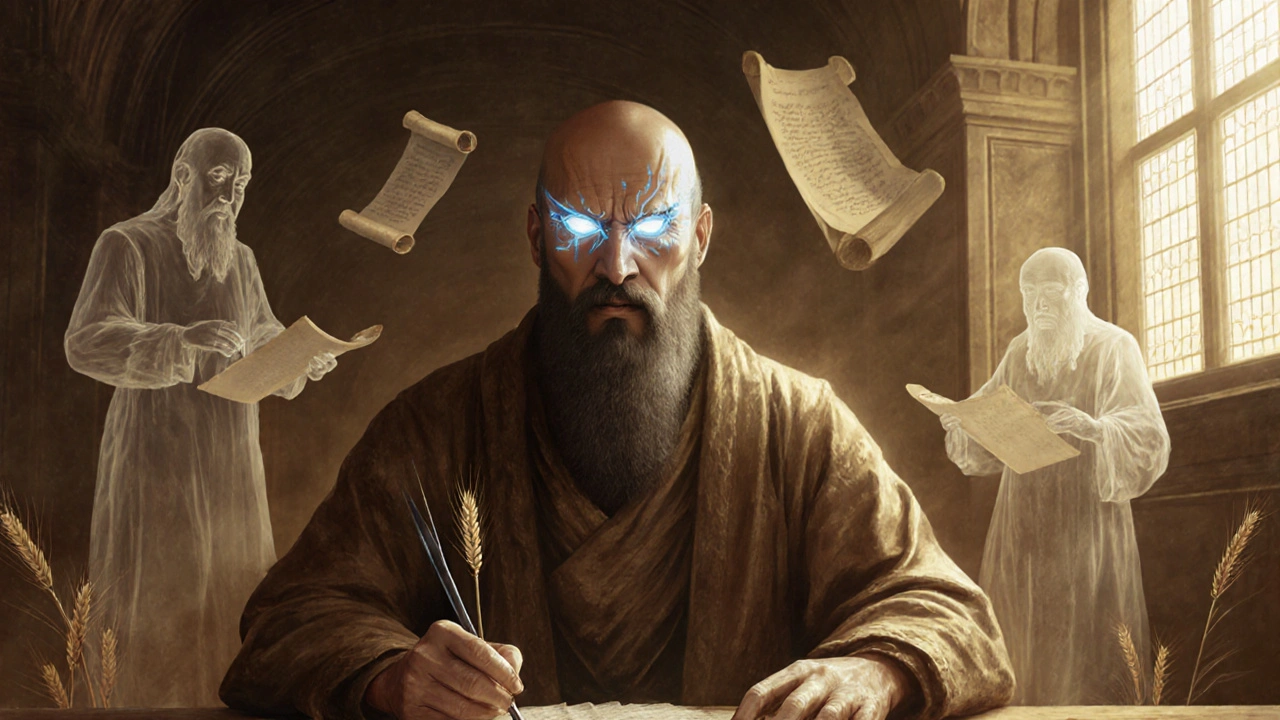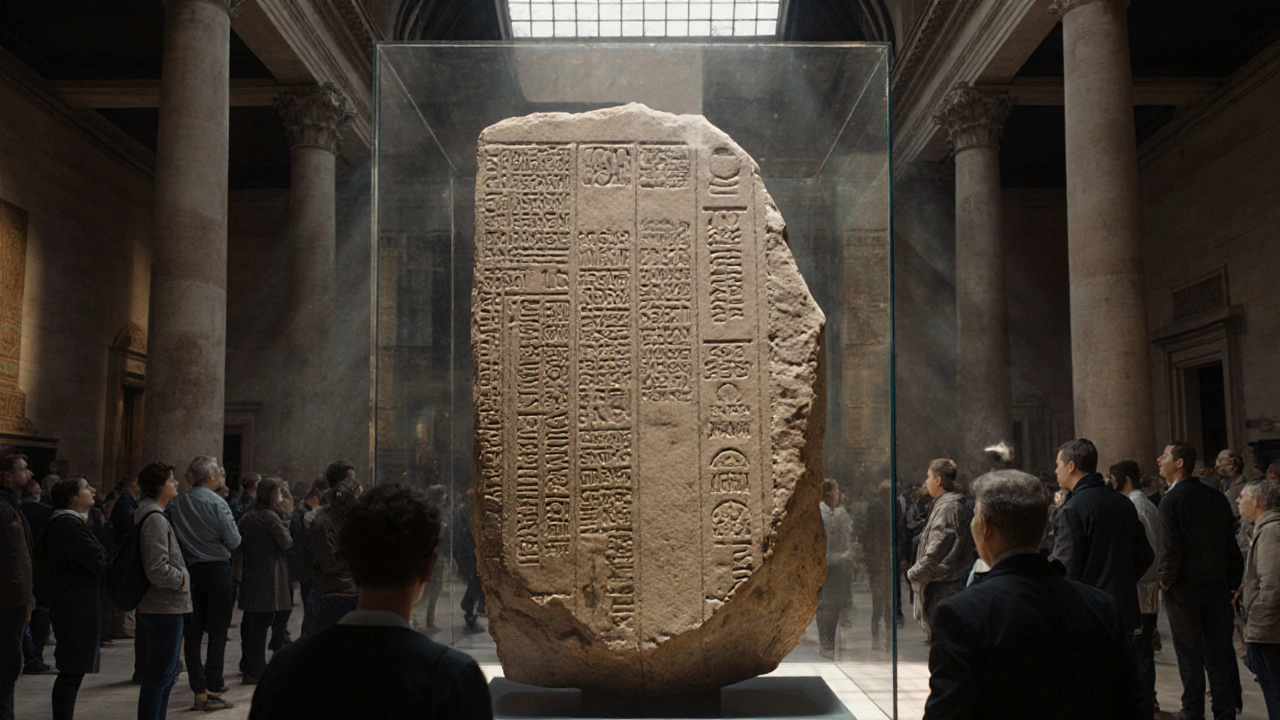The British Museum isn’t just a building full of old stuff-it’s one of the few places on Earth where you can stand face-to-face with the very objects that shaped human history. Over 8 million items. Ten million visitors a year. And yet, most people walk out after seeing just the Rosetta Stone and maybe a few Greek statues. If you’re planning a visit, you’re not here to check a box. You’re here to connect with the past. This guide cuts through the noise and shows you exactly what matters, where to find it, and how to avoid the crowds that ruin the experience.
Start with the Rosetta Stone-But Don’t Stop There
The Rosetta Stone is the museum’s most famous artifact, and for good reason. It’s the key that cracked open ancient Egyptian writing. Before 1822, hieroglyphs were just pretty pictures. After Jean-François Champollion used this stone-carved in 196 BCE with the same text in Greek, Demotic, and hieroglyphic script-to decode the language, entire libraries of lost history became readable. It’s not just a relic. It’s a breakthrough.
Find it in Room 4, the Egyptian Sculpture Gallery. It’s surrounded by crowds, but don’t let that fool you. The real magic is in the details. Look closely at the top section-the hieroglyphs. Notice how the symbols change in size and spacing? That’s not random. It’s a deliberate visual hierarchy. The stone was meant for public display, so the most important parts were made bigger. That’s ancient propaganda.
Don’t leave without glancing at the nearby Black Obelisk of Shalmaneser III. It’s smaller, less famous, but just as powerful. Carved in 825 BCE, it shows tribute payments from conquered kingdoms, including a king of Israel bowing before an Assyrian ruler. It’s the only known image of an Israelite king from the Bible’s time. That’s not just history-it’s a direct link to a biblical figure.
The Parthenon Sculptures: Why They’re Not Just ‘Marbles’
They’re often called the Elgin Marbles, named after the British lord who took them from Athens in the early 1800s. But the British Museum calls them the Parthenon Sculptures-and that’s the right term. These aren’t decorative pieces. They’re the last surviving fragments of the Parthenon’s original decoration, carved between 447 and 432 BCE under the direction of the sculptor Phidias.
Head to Room 18 and Room 19. The sculptures are arranged to mirror how they once sat on the temple: metopes above the columns, friezes wrapping around the inner walls, and pediments at the ends. The east pediment shows the birth of Athena. The west shows her contest with Poseidon for control of Athens. One figure-the horse of the sun god Helios-has been broken into dozens of pieces. But even in fragments, the movement is alive. You can feel the wind in the fabric, the strain in the muscles.
Most visitors snap a photo and move on. But if you stand still for five minutes, you’ll notice something: these aren’t idealized gods. They’re human. Their faces show exhaustion, surprise, pain. That’s what made Greek sculpture revolutionary. Before this, statues were stiff and symbolic. The Parthenon figures breathe. They think. They feel.
And yes, the controversy is real. Greece wants them back. The museum says they’re safer here. But here’s the truth: you don’t need to pick a side to appreciate them. Just know they’re part of a much bigger story about empire, ownership, and cultural memory.
The Must-See Galleries You’re Probably Missing
Most people stick to the Egyptian and Greek halls. That’s fine. But you’re missing half the museum’s soul. Here are three galleries that change how you see history.
- Room 24: The Sutton Hoo Treasure-This is what a real Anglo-Saxon king was buried with. A 27-meter ship, buried in 625 CE, filled with gold, silver, and iron. The helmet? It’s not just a war mask-it’s a spiritual symbol. The faceplate has eyes, a nose, and a mouth carved to look like a warrior’s face. But the eyebrows are two snakes. That’s not decoration. It’s protection. This was armor for the soul.
- Room 67: Ancient Egypt and Sudan-Not the flashy mummies. Look at the Seated Scribe. Made around 2500 BCE, it’s one of the oldest realistic portraits ever made. His eyes are made of crystal and rock crystal, with copper eyelids. He’s not a pharaoh. He’s a clerk. And he’s staring right at you, as if he’s been waiting 4,500 years to hand you a scroll.
- Room 34: The Enlightenment Gallery-This room was the heart of the museum’s founding in 1759. It’s filled with objects collected by scholars who believed knowledge could change the world. You’ll find a 2,000-year-old Roman sundial next to a Polynesian navigation chart and a Chinese porcelain teapot. These weren’t just curiosities. They were tools for understanding humanity’s diversity. That’s why the museum was built-to collect, not to hoard.

How to Navigate the Museum Like a Local
The British Museum is huge. It’s easy to get lost. Here’s how to make the most of your time without walking 10 miles.
- Enter through the Great Court. It’s the most beautiful space in the building-a glass roof over a courtyard with a reading room in the center. Take a second to look up. That’s the largest covered square in Europe.
- Use the free map at the entrance. Don’t rely on your phone. The Wi-Fi is spotty, and the museum’s layout is confusing.
- Start on the ground floor. The Egyptian, Greek, and Roman galleries are all here. Save the Asian and African collections for later-they’re upstairs and less crowded.
- Visit between 10 AM and 11:30 AM. The tour groups arrive after 11. If you come at 3 PM, you’re fighting through 300 people in front of the Rosetta Stone.
- Take the stairs. The elevators are slow. The stairs are quiet. And you’ll see details you’d miss otherwise-like the original 1850s ironwork on the balustrades.
What You Won’t See on Tourist Maps
There’s a small, unmarked door near the back of Room 19. It leads to a narrow corridor. At the end is a single case with a clay tablet from ancient Mesopotamia. It’s not labeled. No signs. Just a 3,700-year-old receipt for barley. Written in cuneiform. It’s from a farmer who paid his tax in grain. The same thing that happened in Babylon. The same thing that happens today when you pay your rent.
That’s the real power of the British Museum. It doesn’t just show you the past. It shows you how we’re still the same people-buying, selling, worshipping, fighting, writing receipts.

Final Tip: Don’t Rush
You don’t need to see everything. You just need to see one thing deeply. Spend 20 minutes with the Seated Scribe. Let the weight of his gaze sink in. Then sit on the bench in Room 24 and watch how sunlight moves across the Sutton Hoo helmet. History isn’t in the labels. It’s in the silence between you and the object.
Is the British Museum free to enter?
Yes, general admission to the British Museum is completely free. You don’t need to book tickets in advance. However, special exhibitions-like the recent Pompeii or Vikings shows-require paid tickets. The permanent galleries, including the Rosetta Stone and Parthenon Sculptures, are always free.
How long should I plan to spend at the British Museum?
If you’re focused, you can see the highlights in 2-3 hours. But if you want to really connect with the artifacts-reading the labels, sitting with the objects, noticing the details-you’ll need at least 4-5 hours. Many locals spend half a day here once a month, just to wander and reflect.
Are the Parthenon Sculptures originals?
Yes, every piece on display is an original from the Parthenon temple in Athens, carved between 447 and 432 BCE. They were removed by Lord Elgin in the early 1800s when Greece was under Ottoman rule. The sculptures have been in London ever since. Some pieces remain in Athens, and others are lost or damaged beyond repair.
Can I take photos inside the museum?
Yes, photography is allowed in most galleries for personal use. No flash, no tripods, and no selfie sticks. Some special exhibitions ban photos entirely-look for signs at the entrance. The Rosetta Stone and Parthenon Sculptures are fine to photograph, but be respectful of crowds.
Is the British Museum family-friendly?
Absolutely. The museum offers free family trails, activity sheets, and interactive touch screens in key galleries. Kids love the Sutton Hoo helmet and the giant Assyrian bull statues. There’s also a dedicated family café with high chairs and kid-friendly meals. Just avoid the busiest hours-mornings are best for families.
What’s the best way to get to the British Museum?
The closest Tube station is Tottenham Court Road (Central and Northern lines), just a 5-minute walk. Holborn and Russell Square are also nearby. Buses 1, 8, 25, 55, 98, and 242 stop right outside. If you’re walking from Covent Garden or Soho, it’s a pleasant 15-minute stroll through historic London streets.
What to Do Next
After your visit, don’t just go home. Go to the museum shop and pick up a copy of The British Museum: A History by Neil MacGregor. It’s not a glossy catalog-it’s a series of essays where each object tells a story about how cultures connect. Or, better yet, come back in six months. The museum rotates its displays. You’ll see new things. And you’ll understand the old things differently.
